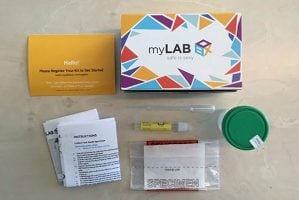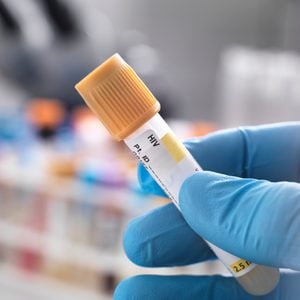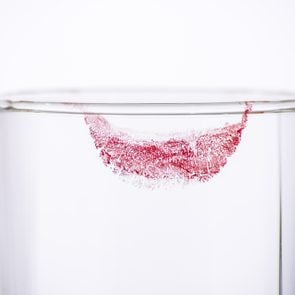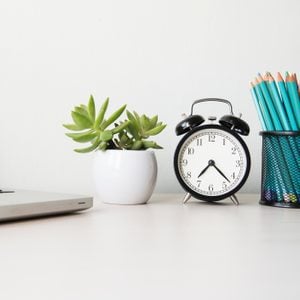I Tried a Home STD Testing Kit: Here’s What Happened
Updated: Feb. 10, 2021
The day has finally come where you can get an at-home STD test—without a trip to your gyno. Should you give it a try?
Our editors and experts handpick every product we feature. We may earn a commission from your purchases.
I’m a total wimp when it comes to going to any type of doctor’s office, which is why I found the idea of an at-home STD test so appealing. Yes, I can appreciate the importance of doctors and totally agree that you should see yours regularly for check-ups. But I tend to put my appointments off as long as possible, especially my yearly gyno visit [because who really wants to ask these 10 totally embarrassing questions at the OB/GYN?]. So when I found out that I could do an at-home STD testing kit, I could hardly contain my excitement. No getting completely undressed and wearing one of those paper robes that never seem to fully cover you and somehow always manages to rip right down the butt (probably due to all the nervous sweating). No having to put my feet in the stirrups. And no trying to make small-talk while my innermost lady parts are probed and poked. [Gynecologists have pet peeves about us, too.]
 The myLAB STD test kit options
The myLAB STD test kit options
Thanks to myLAB Box, I was able to do an entire home STD test (vaginal swab and finger prick) from the comfort of my very own living room while sitting on the couch in PJs. MyLAB Box was founded by two female entrepreneurs who champion the “safe is sexy” motto with the premise of providing a quick, easy, at-home STD kit. The company also offers an at-home chlamydia test, along with kits that test for diseases like HIV, herpes, and gonorrhea. You have the option to pick which kit you want and how many tests you want. For example, there’s four-panel, eight-panel, and 13-panel test kits, along with single tests that range anywhere from $79 for one test to $499 for a comprehensive test for two people. Men and women have access to most of the same STD test kits, however, may have to give different samples, like urine, blood, and swabbing either the inside of the penis, vagina, or anus. [By the way, did you know you can get an at-home colonoscopy test these days too?]
I tried out the four-panel Safe Box which tested for major STDs: HIV, chlamydia, gonorrhea, and trichomoniasis. The kit arrived in a tiny box that had all of the necessary items, like those extra-long Q-tip things, alcohol pads, Band-Aids, gauze, a finger prick, and liquid-filled test tubes. Before doing the tests, I created my online account where I was able to track my shipment and access lab results.
How the myLab Box kit works
Now I was expecting a detailed novel when it came to instructions, (after all, this is medicine), but they were actually pretty brief. Too brief in that I really had no idea what I had to do with what equipment. And the pictures they provided only made things more confusing. What the heck was I looking at? Is that the female anatomy? [Here are health myths gynecologists say you can safely ignore.]
After semi-figuring out what I was supposed to do with each tool, I began the STD test kit. I swabbed the inside of my vagina with the long Q-tip and immediately stuck it in the test tube. “Wow, that was easy,” I thought. While I was a lot more comfortable doing it myself, I did worry that I did it incorrectly or didn’t stick the Q-tip up far enough. Don’t doctors go to medical school to learn all this? I, clearly, did not.
Things got a little harder for me when it came time for the blood test. When I was younger, I had to be pinned down by both my mom and the nurse when it came time to get my shots. I’d kick and scream and cry and yell “I hate you” over and over again, so you can imagine how thrilled I was that the STD testing requires a finger prick. [Needles and blood are more common fears, but have you heart of these other strange phobias?]
Luckily, the kit comes with two of everything because the first time I attempted to do the finger prick blood test, I chickened out and had to toss the first finger pricker in the trash. With a little encouragement from my big sister via text (Thanks, Court!), I was able to do it the second time around. After pricking my finger, I squeezed out the blood and filled four tiny circles on a mini-sheet of paper that reminded me of face oil blotting sheets.
15 minutes in all
The entire test took about 15 minutes to complete. And even though the instructions could definitely use some improvement, the test was easy to do overall, even for us non-medical professionals. Once everything was finished, I put the test tubes in plastic hazard bags back into the original box and then into the USPS shipping envelope they send you with the kit. I dropped it in a regular mailbox and that was it. I was expecting to receive my results the next day because they do say results within 24 hours on their website, but in reality, it took exactly a week. That was frustrating—but I did have to account for travel time, after all. I put the box in the mail on a Tuesday morning and received an email about my results the following Tuesday around 6 p.m. My results were negative. (Phew!) But if something came back positive, myLAB Box provides you with a free physician consultation over the phone and the necessary medication, which is pretty awesome. They do, however, suggest that you go in and see your actual doctor too [even if it’s during your period.]
All in all, I would totally do another STD testing kit from myLAB Box. I love the idea of being able to do it from your own home, which might help decrease the number of undiagnosed STDs—which the CDC estimates cause 24,000 cases of infertility in women each year. And with STDs on the rise (more than two million cases of STDs in 2017 alone), anything we can do to encourage testing is a good thing. [Another option is an at-home STD test subscription plan.]
That being said, as much as I hate going to the gyno (those metal stirrups give me nightmares), I still think it’s important to go see your actual doctor who can do a physical examination. When it comes to your health, it’s better to be safe than sorry.
Next, check out these DIY home-health tests that could save your life.


